Salmon products, fish viscera candidates for shrimp feed ingredients
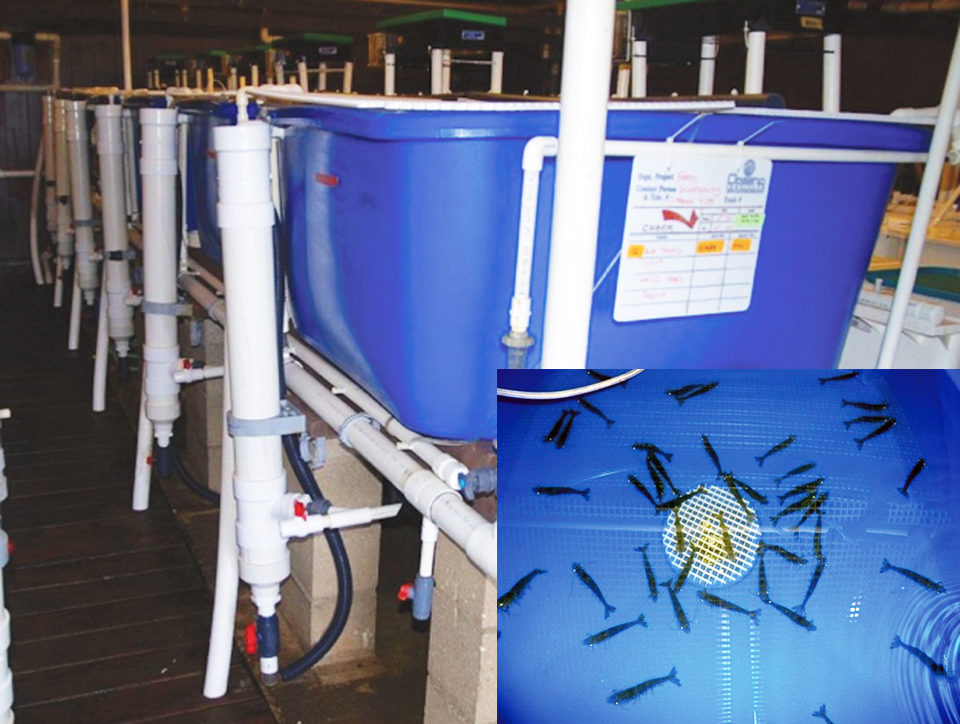
With the rapid global expansion and increased production of aquaculture, increases in aquatic feed production are challenged by the availability of traditional ingredients such as fishmeal and fish oil, and environmental sustainability. Therefore, alternative ingredients are being explored to replace traditional ingredients to meet the demands of the fast-growing feed industry. For example, utilization of by-products from different industries in aquatic feeds is becoming attractive.
Beyond the nutritional composition of an ingredient and its effect on palatability, digestibility is often a concern in aquatic feeds. In a study funded through a grant from the U.S. Department of Agriculture Agricultural Research Service and a cooperative agreement with the University of Alaska – Fairbanks, the authors determined the digestibility of six fisheries by-products in shrimp feed.
Digestibility study
Alaska has the largest number of fisheries in any United States state. Its annual fisheries production totals 1.84 mmt, and processing generates significant amounts of by-products. Previous research by the authors demonstrated that some fisheries by-products contained significant amounts of nutrients and exhibited a stimulating effect on shrimp fed plant protein-based diets.
For this digestibility study, six Alaskan fisheries by-products from processing plants in Kodiak, Alaska, were supplied by the University of Alaska’s Fishery Industrial Technology Center (Table 1). A reference diet containing 40.0 percent protein and 9.0 percent lipid was formulated with 34.2 percent menhaden fishmeal, 32.7 percent whole wheat, 12.5 percent soybean meal, 6.0 percent vital wheat gluten, 5.0 percent brewer’s yeast, 2.5 percent squid meal, 2.0 percent soy lecithin, 1.6 percent menhaden oil, 1.0 percent chromic oxide and 4.5 percent other ingredients, including vitamins and minerals. Chromic oxide was used as a marker to estimate digestibility.
Deng, Proximate composition, Table 1
| Ingredient | Moisture (g/kg) | Ash (g/kg) | Protein (g/kg) | Lipid (g/kg) | Energy (kJ/kg) |
|---|---|---|---|---|---|
| Menhaden fishmeal | 82.9 | 201.0 | 603.3 | 105.2 | 17.9 |
| Pollock bones | 127.8 | 416.4 | 380.9 | 40.8 | 10.0 |
| Tanner crab carapaces and viscera | 49.4 | 282.4 | 358.6 | 87.0 | 12.9 |
| Pink salmon livers | 102.7 | 41.4 | 686.3 | 102.0 | 20.9 |
| Pink salmon milt | 95.3 | 83.9 | 814.6 | 48.9 | 18.8 |
| Arrowtooth heads and viscera | 112.8 | 105.0 | 329.7 | 370.7 | 24.4 |
| Black cod viscera | 293.3 | 73.2 | 421.7 | 208.9 | 19.7 |
The test diets were formulated by replacing the reference diet with 30 percent by-product. The diets were milled to a pellet size of 2.4 x 4 mm.
The digestibility trial was conducted in an indoor system with flow-through water and a photoperiod with 12 hours light and 12 hours dark. Four replications were used for each dietary treatment. In trial 1, 6-g shrimp were stocked at 100/tank, and in trial 2, 14-g shrimp with 75 shrimp/tank were stocked. Shrimp were fed 10 percent of body weight for two hours before fecal samples were collected. Water quality was monitored during the trials, with temperature at 26.5 ± 0.2 degrees C, salinity at 31.0 ± 0.3 ppt, dissolved oxygen at 6.0 ± 0.3 mg/L, pH at 7.8 ± 0.1 and total ammonia nitrogen below 0.08 mg/L.
Nutrient composition
Proximate composition analysis of the tested by-products showed that the salmon livers and milt meal had higher protein levels than menhaden fishmeal (Table 1). The rest of the by-products had lower protein levels than the fishmeal, but still contained significant levels of crude protein ranging from 35 to 42 percent.
The crude protein level for the black cod viscera could be increased from 42 to 50 percent if moisture could be removed from the product. Some by-products, such as the arrowtooth heads and viscera, and the cod viscera, were found to be rich lipid sources. The by-products from crab carapaces and viscera, and pollock bones had very high ash content. All the by-products except pollock bones and crab carapaces/viscera contained higher gross energy than the fishmeal.
Apparent digestibility
The apparent digestibility coefficients (ADCs) of the test diets showed that the diets containing salmon livers or milt had the same digestibility as the reference diet, except that the lipid ADC was lower than for the reference diet (Table 2). The ADCs of test diets containing pollock bones or the crab carapaces and viscera were significantly lower than the ADC for the reference diet. The ADCs of nutrients for the diets with arrowtooth heads and viscera or black cod viscera were similar to the ADC of the reference diet.
Deng, Apparent digestibility, Table 2
| Diet | Dry Matter (%) | Protein (%) | Lipid (%) | Energy (%) |
|---|---|---|---|---|
| Trial 1 | ||||
| Reference | 60.0 ± 1.1c | 85.7 ± 0.4bc | 91.8 ± 0.3c | 76.6 ± 0.6bc |
| Pollock bones | 33.2 ± 1.3a | 78.3 ± 0.6a | 88.0 ± 0.8b | 67.9 ± 0.9a |
| Crab carapaces and viscera | 49.3 ± 1.4b | 77.7 ± 1.0a | 87.5 ± 0.9b | 68.1 ± 1.1a |
| Pink salmon livers | 61.6 ± 1.3c | 84.8 ± 0.4b | 78.3 ± 0.9a | 74.0 ± 0.8b |
| Pink salmon milt | 60.1 ± 0.3c | 87.9 ± 0.2c | 88.6 ± 0.5b | 77.7 ± 0.2c |
| Trial 2 | ||||
| Reference | 58.7 ± 0.8b | 81.5 ± 0.8a | 88.4 ± 0.7ab | 75.6 ± 0.8a |
| Arrowtooth heads and viscera | 54.8 ± 0.6a | 79.3 ± 0.6a | 89.7 ± 1.3b | 76.5 ± 0.6a |
| Black cod viscera | 57.9 ± 1.1ab | 84.2 ± 0.5b | 86.0 ± 0.6a | 74.9 ± 0.9a |
Among all by-products, the ADC for crude protein was the highest for the salmon milt, followed by those for the black cod viscera and the arrowtooth heads and viscera, which had values similar to that for the salmon liver (P > 0.05) (Figure 1). The pollock bone and crab carapace and viscera treatments exhibited significantly lower ADC values for crude protein than the other by-products did.
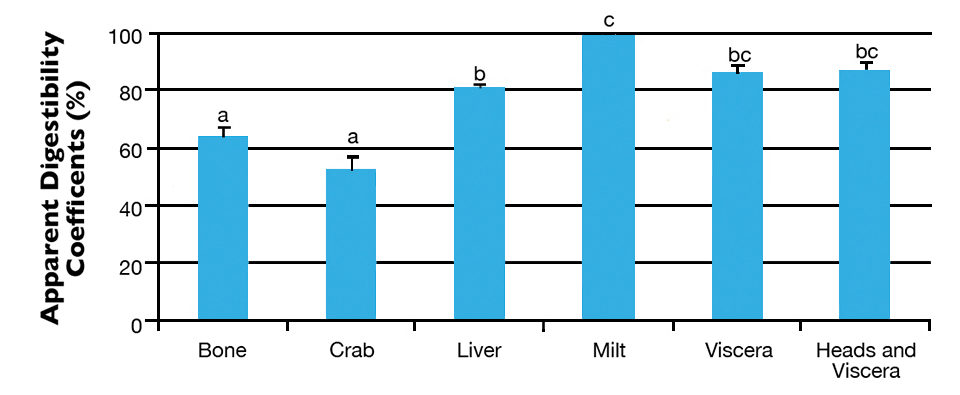
The ADC values for crude lipid were significantly lower for the pollock bones and salmon livers than the other by-products (Figure 2). Although not presented, the ADC values for gross energy were lower for the pollock bone and crab carapace/viscera treatments than those for the remaining by-products used in the test.
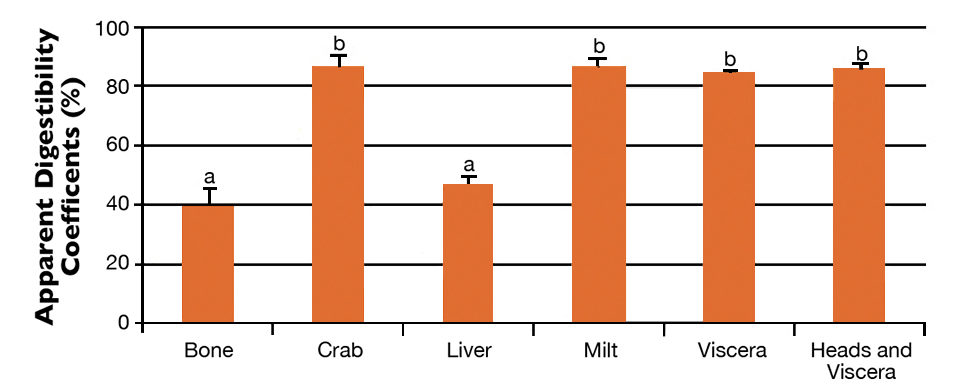
Perspectives
The study demonstrated that by-products from salmon livers and milt, black cod viscera, and arrowtooth heads and viscera were easily digested by Pacific white shrimp. These by-products are also rich in protein and/or lipids.
Previous studies have shown that supplementation of these by-products in shrimp feed stimulated feeding in shrimp fed a plant protein-based diet. Therefore, based on evaluation of the proximate compositions of the by-products and their effects on palatability and digestibility in shrimp, the by-products can be considered good candidates as ingredients or additives for shrimp feed. Investigation of their effects on the growth performance of shrimp will be needed to further support this conclusion.
The low digestibility of pollock bones and crab carapaces and viscera could be due to the high level of ash in these by-products. The authors’ previous studies also showed that these by-products had no stimulating effect on shrimp feeding. Therefore, under current conditions, the by-products are not good candidates for ingredients in shrimp feed.
(Editor’s Note: This article was originally published in the May/June 2012 print edition of the Global Aquaculture Advocate.)
Authors
-
Dong-Fang Deng, Ph.D.
Aquatic Feeds and Nutrition Department
Oceanic Institute
41-202 Kalaniana’ole Highway
Waimanalo, Hawaii 96795 USA[103,114,111,46,101,116,117,116,105,116,115,110,105,99,105,110,97,101,99,111,64,103,110,101,100,102,100]
-
Lytha D. Conquest
Aquatic Feeds and Nutrition Department
Oceanic Institute
41-202 Kalaniana’ole Highway
Waimanalo, Hawaii 96795 USA -
Warren G. Dominy, Ph.D.
Aquatic Feeds and Nutrition Department
Oceanic Institute
41-202 Kalaniana’ole Highway
Waimanalo, Hawaii 96795 USA -
Peter J. Bechtel, Ph.D.
USDA Agricultural Research Service
Subarctic Agricultural Research Unit
Fishery Industrial Technology Center
Kodiak, Alaska, USA -
Scott S. Smiley, Ph.D.
Fishery Industrial Technology Center
School of Fisheries & Ocean Sciences
University of Alaska
Kodiak, Alaska, USA
Tagged With
Related Posts

Aquafeeds
A look at protease enzymes in crustacean nutrition
Food digestion involves digestive enzymes to break down polymeric macromolecules and facilitate nutrient absorption. Enzyme supplementation in aquafeeds is a major alternative to improve feed quality and nutrient digestibility, gut health, compensate digestive enzymes when needed, and may also improve immune responses.
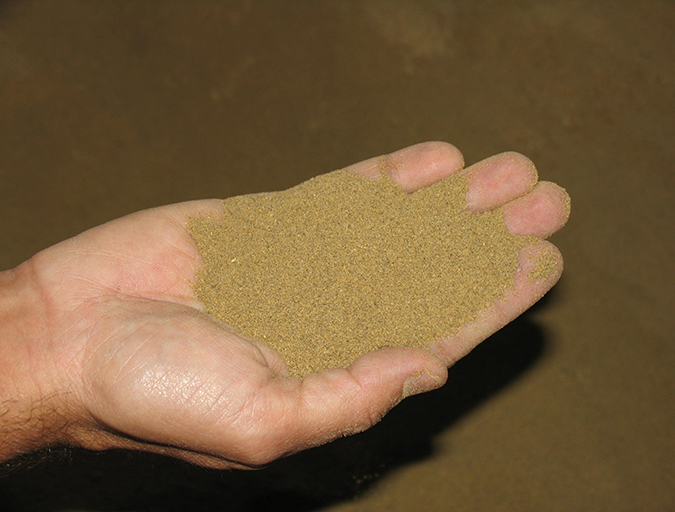
Aquafeeds
A look at the SME controlled extrusion process
A study was conducted using a Twin-Screw Extruder equipped with Specific Mechanical Energy (SME) and Density Control valves, to determine the effect of SME on the water stability of shrimp feeds. Further research is needed to evaluate the performance.
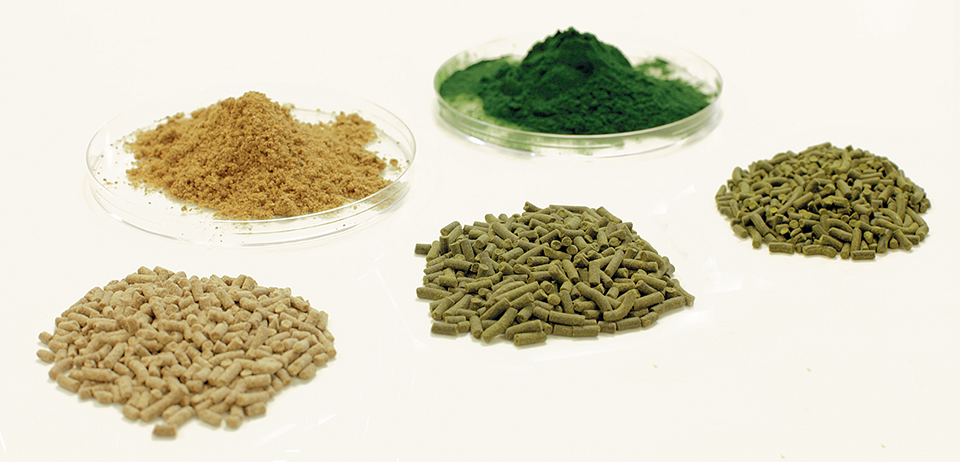
Aquafeeds
Algae alternative: Chlorella studied as protein source in tilapia feeds
Chlorella and other species have potential as protein sources in aquafeeds. In trials with tilapia fry raised in a recirculating system, the fish received a fishmeal-based control diet or feeds with portions of the fishmeal replaced by Chlorella.
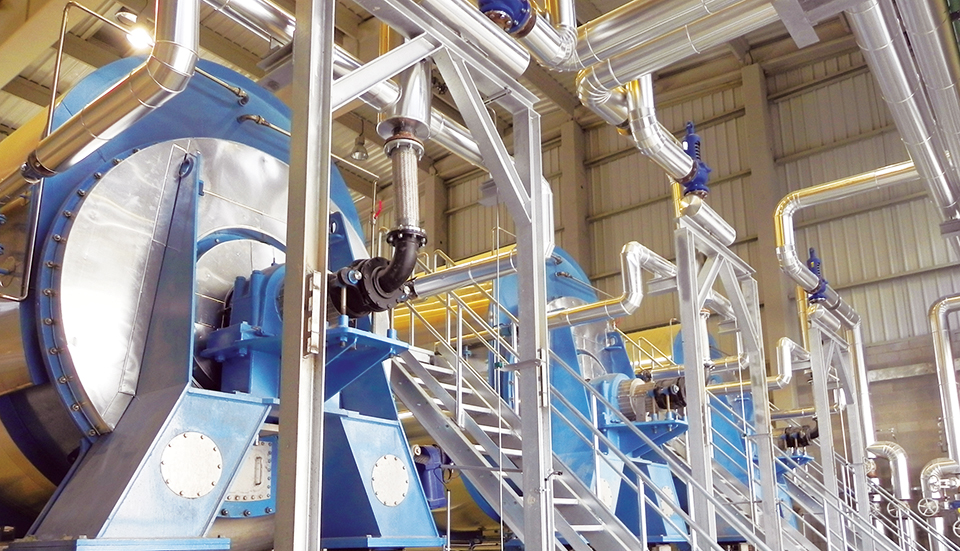
Aquafeeds
Animal byproduct concentrates useful tools in formulation
With the market volatility of fishmeal, as well as rising sustainability concerns, the aquaculture industry is seeking sources of protein, such as animal byproduct concentrates, to substitute for fishmeal.


